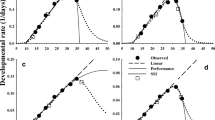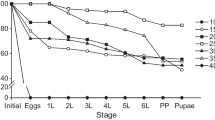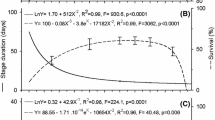Abstract
The melon fruit fly Zeugodacus cucurbitae (Coquillett) is a major polyphagous insect pest with a worldwide distribution. The effects of temperature on the development of Z. cucurbitae were investigated at eight constant temperatures. Freshly deposited egg and emerged larvae of Z. cucurbitae were used for experiment and the development of eggs, larvae and pupae was examined daily. With the exception of the lowest temperature (12.0 °C), Z. cucurbitae developed successfully from the egg stage to the adult stage at all the assessed temperatures. The lower developmental thresholds and thermal constants of each life stage were determined using linear regression. The lower and higher temperature thresholds were estimated using the Lobry–Rosso–Flandrois (LRF) and Sharpe–Schoolfield–Ikemoto (SSI) models. The lower developmental threshold and thermal constant from egg to adult emergence were 10.7 °C and 218.7 degree-days, respectively. The intrinsic optimum temperatures of the egg, larval, pupal and egg to pupal stages were 30.3, 24.4, 24.5, and 25.7 °C, respectively. Using the SSI model, we determined a temperature range of 23.1 °C (13.3–36.4 °C) for the total immature stage of Z. cucurbitae from lower and higher temperature threshold. The cumulative 50% adult emergence estimated using the SSI model was approximately 1 day later than that observed from Momordica charantia L., which was used for validating the distribution of adult Z. cucurbitae emergence. We elucidated the thermal performance of Z. cucurbitae using linear and non-linear models, and these models will contribute to the development of an effective management program for Z. cucurbitae.






Similar content being viewed by others
Notes
A degree day is a measure of heating and is the amount of heat required to complete a given organism’s development.
Total immature period means from egg to pupal period.
References
Ahn, J. J., Son, Y., He, Y., Lee, E., & Park, Y.-L. (2016). Effects of temperature on development and voltinism of Chaetodactylus krombeini (Acari: Chaetodactylidae): implications for climate change impacts. PLoS ONE, 11, e0161319.
Back, E. A., & Pemberton, C. E. (1914). Life history of the melon fly. Journal of Agricultural Research, 3, 269–274.
Badii, K. B., Billah, M. K., Afreh-Nuamah, K., Obeng-Ofori, D., & Nyarko, G. (2015). Review of the pest status, economic impact and management of fruit-infesting flies (Diptera: Tephritidae) in Africa. African Journal of Agricultural Research, 10, 1488–1498.
Barma, P., Jha, S., & Banerjee, S. (2013). Prediction of population development of melon fruit fly (Bactrocera cucurbitae Coq.) on pointed gourd (Trichosanthes dioica Roxb.). African Journal of Agricultural Research, 8, 4740–4747.
Campbell, A., Frazer, B. D., Gilbert, N., Gutierrez, A. P., & Mackauer, M. (1974). Temperature requirements of some aphids and their parasites. Journal of Applied Ecology, 11, 431–438.
Carey, J. R., & Dowell, R. V. (1989). Exotic fruit fly pests and California agriculture. California Agriculture, 43, 38–40.
Carey, J. R., Papadopoulos, N., & Plant, R. (2017). The 30-year debate on a multi-billion-dollar threat: Tephritid fruit fly establishment in California. American Entomologist, 63, 100–113.
Chen, S., Fleischer, S., Tobin, P. C., & Saunders, M. C. (2011). Projecting insect voltinism under high and low greenhouse gas emission conditions. Environmental Entomology, 40, 505–515.
De Meyer, M., Delatte, H., Mawtawala, M., Quilici, S., Vayssieres, J.-F., & Virgilio, M. (2015). A review of the current knowledge on Zeugodacus cucurbitae (Coquillett) (Diptera, Tephritidae) in Africa, with a list of species included in Zeugodacus. ZooKeys, 540, 539–557.
Dhillon, M. K., Singh, R., Naresh, J. S., & Sharma, H. C. (2005). The melon fruit fly, Bactrocera cucurbitae: A review of its biology and management. Journal of Insect Science, 5, 40.
Dixon, A. F. G., Honĕk, A., Kell, P., Kotela, M. A. A., Šizling, A. L., & Jarošik, V. (2009). Relationship between the minimum and maximum temperature thresholds for development in insects. Functional Ecology, 23, 257–264.
Doorenweerd, C., Leblanc, L., Norrbom, A. L., Jose, M. S., & Rubinoff, D. (2018). A global checklist of the 932 fruit fly species in the tribe Dacini (Diptera, Tephritidae). ZooKeys, 730, 19–56.
Duyck, P.-F., David, P., & Quilici, S. (2004). A review of relationship between interspecific competition and invasions in fruit flies (Diptera: Tephritidae). Ecological Entomology, 29, 511–520.
Farooq, M., Baig, S., Honey, S. F., Bajwa, B. E., & Fazlullah, & Shar, I. H. (2020). Evaluation of host susceptibility, preference and offspring performance of Zeugodacus cucurbitae (Coquillett) (Diptera: Tephritidae) on different hosts. International Journal of Tropical Insect Science, 40, 93–99.
Follett, P. A., Jamieson, L., Hamilton, L., & Wall, M. (2019). New association and host status: Infestability of kiwifruit by the fruit fly species Bactrocera dorsalis, Zeugodaucs cucurbitae and Ceratitis capitate (Diptera: Tephritidae). Crop Protection, 115, 113–121.
González-Tokman, D., Córdoba-Aguilar, A., Dáttilo, W., Lira-Noriega, A., Sánchez-Guillen, R. A., & Villalobes, F. (2020). Insect responses to heat: Physiological mechanisms, evolution and ecological implications in a warming world. Biological Review, 95, 802–821.
Gutierrez, A. P., Ponti, L., Neteler, M., Suckling, D. M., & Cure, J. R. (2021). Invasive potential of tropical fruit flies in temperature regions under climate change. Communications Biology, 4, 1141.
Halsch, C. A., Shapiro, A. M., Fordyce, J. A., Nice, C. C., Thorne, J. H., Waetjen, D. P., & Forister, M. L. (2021). Insects and recent climate change. PNAS, 118, e2002543117.
Hancock, D. L., & Drew, R. A. I. (2018). A review of the subgenus Zeugodacus Hendel of Bactrocera Macquart (Diptera: Tephritidae: Dacinae): An integrative approach. The Australian Entomologist, 45, 251–272.
Hendrichs, J., Vera, M. T., De Meyer, M., & Clarke, A. R. (2015). Resolving cryptic species complexes of major tephritid pests. ZooKeys, 540, 5–39.
Huang, Y., Gu, X., Peng, X., Tao, M., Chen, G., & Zhang, X. (2020). Effect of short-term high-temperatures on the growth, development and reproduction in the fruit fly, Bactrocera tau (Diptera: Tephritidae). Scientific Reports, 10, 6418.
Ikemoto, T. (2005). Intrinsic optimum temperature for development of insects and mites. Environmental Entomology, 34, 1377–1387.
Isabirye, B. E., Akol, A. M., Muyinza, H., Masembe, C., Rwomushana, I., & Nankinga, C. K. (2016). Fruit fly (Diptera: Tephritidae) host status and relative infestation of selected mango cultivars in three agro ecological zones in Uganda. International Journal of Fruit Science, 16, 23–41.
Jackson, C. G., Long, J. P., & Klungness, L. M. (1998). Depth of pupation in four species of fruit flies (Diptera: Tephritidae) in sand with and without moisture. Journal of Economic Entomology, 91, 138–142.
Jandel Scientific. (1996). TableCurve User’s manual San Rafael, CA, US.
Jiang, C. (2005). The population system and integrated quarantine and management of melon fly. Thesis. Ph.D. Fujian Agricultural and Forestry University.
Keck, C. B. (1951). Effect of temperature on development and activity of the melon fly. Journal of Economic Entomology, 44, 1001–1002.
Kim, D.-S., Ahn, J. J., & Lee, J.-H. (2017). A review for non-linear models describing temperature-dependent development of insect populations: Characteristics and developmental process of models. Korean Journal of Applied Entomology, 56, 1–18.
Koidsumi, K., & Shibata, K. (1964). Possible distribution and establishment of two species of tropical fruit flies, melon fly and oriental fruit fly, in Japan and its adjacent temperate countries. I. Effective, favorable and the lowest temperature for the development and reproduction of both flies and their relations to the distribution and abundance in the world and especially in Japan and other oriental countries. Japanese Journal of Applied Entomology and Zoology, 8, 11–20.
Kontodimas, D. C., Eliopoulos, P. A., Stathas, G. J., & Economou, L. P. (2004). Comparative temperature-dependent development of Nephus includens (Kirsch) and Nephus bisignatus (Boheman) (Coleoptera: Coccinellidae) preying on Planococcus citri (Risso) (Homoptera: Pseudococcidae): Evaluating of a linear and various nonlinear models using specific criteria. Environmental Entomology, 33, 1–11.
Koyama, J., Kakinohana, H., & Miyatake, T. (2004). Eradication of the melon fly, Bactrocera cucurbitae, in Japan: Importance of behavior, ecology, genetics and evolution. Annual Review of Entomology, 49, 331–349.
Krosch, M. N., Schutze, M. K., Armstrong, K. F., Graham, G. C., Yeates, D. K., & Clarke, A. R. A. (2012). A molecular phylogeny for the tribe Dacini (Diptera: Tephritidae): Systematic and biogeographic implications. Molecular Phylogenetics and Evolution, 64, 513–523.
Lobry, J. R., Rosso, L., & Flandrois, J. P. (1991). A FORTRAN subroutine for the determination of parameter confidence limits in non-linear models. Binary, 3, 86–93.
Martin-Vertedor, D., Ferrero-Garcia, J. J., & Torres-Vila, L. M. (2010). Global warming affects phenology and voltinism of Lobesia botrana in Spain. Agricultural and Forest Entomology, 12, 169–176.
Mcinnis, D. O., Hendrichs, J., Shelly, T., Barr, N., Hoffman, K., Rodriguez, R., Lance, D. R., Bloem, K., Suckling, D. M., Enkerlin, W., Gomes, P., & Tan, K. H. (2017). Can polyphagous invasive tephritid pest populations escape detection for years under favorable climatic and host conditions? American Entomologist, 63, 89–99.
Messenger, P. S., & Flitters, N. E. (1958). Effect of constant temperature environments on the egg stage of three species of Hawaiian fruit flies. Annuals of the Entomological Society of America, 51, 109–119.
Mir, S. H., Dar, S. A., Mir, G. M., & Ahmad, S. B. (2014). Biology of Bactrocera cucurbitae (Diptera: Tephritidae) on cucumber. Florida Entomologist, 97, 753–758.
Mirhosseini, M. A., Fathipour, Y., & Reddy, G. V. P. (2017). Arthropod development’s response to temperature: A review and new software for modeling. Annuals of the Entomological Society of America, 110, 507–520.
Mkiga, A. M., & Mwatawala, M. W. (2015). Developmental biology of Zeugodacus cucurbitae (Diptera: Tephritidae) in three cucurbitaceous hosts in different temperature regimes. Journal of Insect Science, 15, 160.
Mwatawala, M. W., de Meyer, M., Makundi, R. H., & Maerere, A. P. (2006). Biodiversity of fruit flies (Diptera, Tephritidae) at orchards in different agroecological zones of the Morogoro region, Tanzania. Fruits, 61, 321–332.
Nakamori, H., & Kakinohana, H. (1980). Mass production of the melon fly, Dacus cucurbitae Coquillett, in Okinawa, Japan. Review of Plant Protection Research, 13, 37–53.
Nakamori, H., Soemori, H., & Kakinohana, H. (1978). Effect of temperature on pupal development of the melon fly, Dacus cucurbitae Coq. And a method to control the timing of adult emergence. Japanese Journal of Applied Entomology and Zoology, 22, 56–59.
Papadopoulos, N., Plant, R. E., & Carey, J. R. (2013). From trickle to flood: The large-scale, cryptic invasion of California by tropical fruit flies. Proceedings of the Royal Society B, 280, 20131466.
Piñero, J. C., & Ja´come, I., Vargas, R. I., & Prokopy, R. J. (2006). Response of female melon fly, Bactrocera cucurbitae, to host-associated visual and olfactory stimuli. Entomologia Experimentalis Et Applicata, 121, 261–269.
Putulan, D., Sar, S., Drew, R. A. I., Raghus, S., & Clarke, A. R. (2004). Fruit and vegetable movement on domestic flights in Papua New Guinea and the risk of spreading pest fruit-flies (Diptera: Tephritidae). International Journal of Pest Management, 50, 17–22.
R Core Team. (2015). R: A language and environment for statistical computing. R foundation for statistical computing. http://www.r-project.org. Accessed 20 Jan 2020.
Ratkowsky, D. A., & Reddy, G. V. P. (2017). Empirical model with excellent statistical properties for describing temperature-dependent developmental rates of insects and mites. Annuals of the Entomological Society of America, 110, 302–309.
Rosso, L., Lobry, J. R., & Flandrois, J. P. (1993). An unexpected correlation0 between cardinal temperatures of microbial growth highlighted by a new model. Journal of Theoretical Biology, 162, 447–463.
Roy, M., Brodeur, J., & Cloutier, C. (2002). Relationship between temperature and developmental rate of Stethorus punctillum (Coleoptera: Coccinellidae) and its prey Tetranychus mcdanieli (Acarina: Tetranychidae). Environmental Entomology, 31, 177–187.
Samayoa, A. C., Choi, K. S., Wang, Y.-S., Hwang, S.-Y., Huang, Y.-B., & Ahn, J. J. (2018). Thermal effects on the development of Bactrocera dorsalis (Hendel) (Diptera: Tephritidae) and model validation in Taiwan. Phytoparasitia, 46, 365–376.
SAS Institute. (2002). SAS user’s guide; statistics version 9.4 ed. SAS Institute.
Schoolfield, R. M., Sharpe, P. J. H., & Magnuson, C. E. (1981). Non-linear regression of biological temperature-dependent rate models based on absolute reaction-rate theory. Journal of Theoretical Biology, 88, 719–731.
Sharpe, P. J. H., & DeMichele, D. W. (1977). Reaction kinetics of poikilotherm development. Journal of Theoretical Biology, 64, 649–670.
Shi, P.-J., Reddy, G. V. P., Chen, L., & Ge, F. (2017). Comparison of thermal performance equations in describing temperature-dependent developmental rates of insects: (II) two thermodynamic models. Annuals of the Entomological Society of America, 110, 113–120.
Shi, P.-J., Reddy, G. V. P., Chen, L., & Ge, F. (2016). Comparison of thermal performance equations in describing temperature-dependent developmental rates of insects: (1) empirical models. Annuals of the Entomological Society of America, 109, 211–215.
van der Have, T. M. (2002). A proximate model for thermal tolerance in ectotherms. Oikos, 98, 141–155.
Vargas, R. I., Pinero, J. C., & Leblanc, L. (2015). An overview of pest species of Bactrocera fruit flies (Diptera: Tephritidae) and the integration of biopesticides with other biological approaches for their management with a focus on the Pacific region. Insects, 6, 297–318.
Vargas, R. I., Walsh, W. A., & Kanehisa, D. (2000). Comparative demography of three Hawaiian fruit flies (Diptera: Tephritidae) at alternating temperatures. Annuals of the Entomological Society of America, 93, 75–81.
Vargas, R. I., Walsh, W. A., Kanehisa, D., Jang, E. B., & Armstrong, J. W. (1997). Demography of four Hawaiian fruit flies (Diptera: Tephritidae) reared at five constant temperatures. Annuals of the Entomological Society of America, 90, 162–168.
Vargas, R. I., Walsh, W. A., Jang, E. B., Armstrong, J. W., & Kanehisa, D. T. (1996). Survival and development of immature stages of four Hawaiian fruit flies (Diptera: Tephritidae) reared at five constant temperature. Annuals of the Entomological Society of America, 89, 64–69.
Vargas, R. I., & Carey, J. R. (1990). Comparative survival and demographic statistics for wild oriental fruit fly, Mediterranean fruit fly, and melon fly (Diptera: Tephritidae) on papaya. Journal of Economic Entomology, 83, 1344–1349.
Vargas, R. I., Miyashita, D., & Nishida, T. (1984). Life history and demographic parameters of three laboratory-reared Tephritids (Diptera: Tephritidae). Annuals of the Entomological Society of America, 77, 651–656.
Vayssières, J. F., Carel, Y., Coubes, M., & Duyck, P. F. (2008). Development of immature stages and comparative demography of two cucurbit-attacking fruit flies in Reunion Island: Bactrocera cucurbitae and Dacus ciliatus (Diptera: Tephritidae). Environmental Entomology, 37, 307–314.
Vayssières, J.-F., Rey, J.-Y., & Traore, L. (2007). Distribution and host plants of Bactrocera cucurbitae in west and central Africa. Fruits, 62, 391–396.
Virgilio, M., Jordaens, K., Verwimp, C., White, I. M., & De Meyer, M. (2015). Higher phylogeny of frugivorous flies (Diptera, Tephritidae, Dacini): Localised partition conflicts and a novel generic classification. Molecular Phylogenetics and Evolution, 85, 171–179.
Virgilio, M., Delatte, H., Backeljau, T., & De Meyer, M. (2010). Macrogeographic population structuring in the cosmopolitan agricultural pest Bactrocera cucurbitae (Diptera: Tephritidae). Molecular Ecology, 19, 2713–2724.
Wagner, T. L., Wu, H. I., Sharpe, P. J. H., Schoolfield, R. M., & Coulson, B. N. (1984). Modeling insect development rates: A literature review and application of a biophysical model. Annuals of the Entomological Society of America, 77, 208–225.
Wagner, D. L., Grames, E. M., Forister, M. L., Berenbaum, M. R., & Stopak, D. (2021). Insect decline in the Anthropocene: death by a thousand cuts. PNAS, 118, e2023989118.
Weibull, W. (1951). A statistical distribution functions with wide applicability. Journal of Applied Mechanics, 18, 293–297.
Yang, P., Carey, J. R., & Dowell, R. V. (1994a). Temperature influence on the development and demography of Bactrocera dorsalis (Diptera: Tephritidae) in China. Environmental Entomology, 23, 971–974.
Yang, P., Zhou, C., Liang, G., Dowell, R. V., & Carey, J. R. (1994b). Temperature studies on a Chinese strain of Bactrocera cucurbitae (Coquillett) (Diptera: Tephritidae). Pan-Pacific Entomologist, 70, 269–275.
Acknowledgements
The authors thank Jing-Huan Ling for assisting the experimental process. We would like to thank Editage (www.editage.co.kr) for English language editing. This research was supported by an international cooperative research project (Project Title: Study on the prediction of the occurrence and survival of Zeugodacus cucurbitae against their incursion via climate change, No: PJ01420201) between Taiwan Agricultural Research Institute, Taiwan and National Institute of Horticultural and Herbal Science, Rural Development Administration, Republic of Korea. The authors appreciate Dr. Manoukis and one anonymous reviewer for valuable comments on the manuscripts.
Author information
Authors and Affiliations
Corresponding author
Ethics declarations
Conflict of interest
The authors declare that they have no conflict of interest.
Additional information
Publisher’s note
Springer Nature remains neutral with regard to jurisdictional claims in published maps and institutional affiliations.
Rights and permissions
About this article
Cite this article
Ahn, J.J., Choi, K.S. & Huang, YB. Thermal effects on the development of Zeugodacus cucurbitae (Coquillett) (Diptera: Tephritidae) and model validation. Phytoparasitica 50, 601–616 (2022). https://doi.org/10.1007/s12600-022-00985-5
Received:
Accepted:
Published:
Issue Date:
DOI: https://doi.org/10.1007/s12600-022-00985-5




